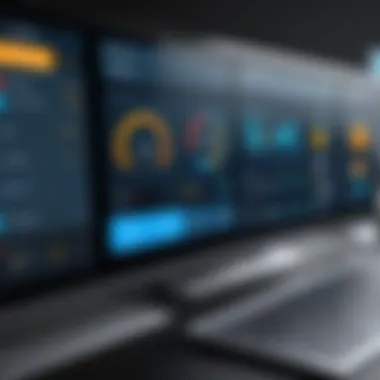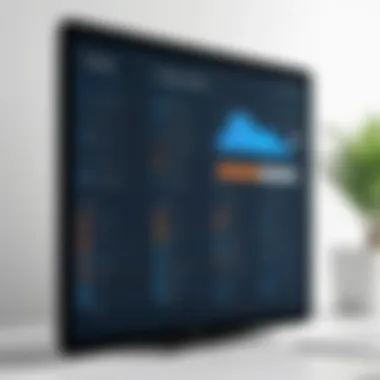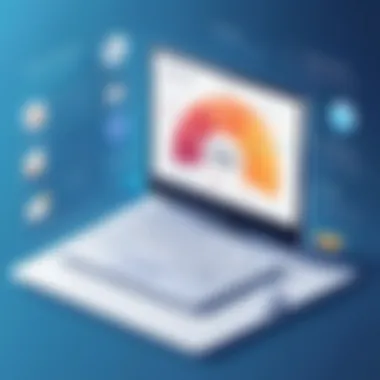Exploring Easy Property Management Software Guide


Intro
The landscape of real estate management is changing swiftly, influenced profoundly by advancements in technology. Easy property management software has emerged as a lifeline for property managers, simplifying complex tasks and enhancing operational efficiency. This guide aims to delve into key features, benefits, and considerations associated with easy property management software. The objective is to furnish readers with insights that enable informed choices when it comes to selecting the right software for their needs.
As the real estate market evolves, so does the demand for tools that not only streamline operations but also provide valuable data insights. In this article, we will explore various leading solutions, address common challenges that users might encounter, and offer practical tips for successful implementation and management of these tools.
Key Features and Functionalities
Comprehensive Overview
When seeking easy property management software, it's crucial to understand the features that can significantly enhance productivity and efficiency. Key functionalities often include:
- Tenant and Lease Tracking: This feature allows managers to monitor lease agreements, renewal dates, and track tenant payments.
- Accounting and Financial Reporting: It simplifies financial management, incorporating rent collection, expense tracking, and generating detailed reports for better financial visibility.
- Maintenance Management: Efficient software will offer a platform for tenants to submit maintenance requests, while managers can monitor the resolution process.
- Document Management: Centralized storage of important files, contracts, and communications facilitates easier access and organization.
- Communication Tools: Enhances interaction between landlords and tenants, ensuring all parties remain informed and engaged.
Target Users
The target users of easy property management software vary widely. They primarily include:
- Property Managers: Responsible for managing multiple properties, they require robust tools for daily operations.
- Landlords: Both professional and individual landlords benefit from user-friendly solutions that streamline management tasks.
- Real Estate Firms: Larger firms with extensive portfolios often rely on advanced software to handle their complex operations.
- Investors: Property investors require software to track performance, expenses, and revenues from their investments.
Pricing Models and Cost Analysis
Choosing the right property management software also means understanding the pricing models available in the market.
Breakdown of Pricing Tiers
Most providers offer tiered pricing based on the features included. Common plans can range from basic to premium, where basic may offer essential features while premium includes advanced analytics and customization options.
- Basic Plans: Typically lower in cost but may have limited features.
- Standard Plans: Moderate pricing with a good balance of features for most users.
- Premium Plans: Higher costs, but include advanced functionalities that cater to larger, more complex management needs.
Additional Costs to Consider
While the subscription fees might be a primary consideration, there are additional costs that can influence the overall expense of using property management software. These include:
- Setup Fees: Some providers charge a one-time setup fee to help with initial configuration.
- Support and Maintenance: Ongoing support can come at an extra cost, particularly for complex systems needing regular upgrades or changes.
- Integration Costs: If the software is to be integrated with other systems or tools, additional costs may arise.
Selecting the right property management software requires careful consideration of both features and costs to ensure a positive return on investment.
In this guide, we will continue to explore the various aspects of property management software, providing clarity and insight to aid in your decision-making process.
Prelims to Property Management Software
The growing complexities in managing properties are pushing real estate professionals to seek innovative solutions. Understanding property management software becomes essential. This section delves into what property management software is and its significance in today's market.
Understanding Property Management
Property management refers to a range of tasks involved in the operation and oversight of real estate. It encompasses various activities such as maintaining the property, handling tenant requests, and ensuring compliance with laws and regulations. Each of these tasks can become overwhelming, particularly as the number and type of properties expand. Effective property management not only enhances operational efficiency but also improves tenant satisfaction. Property managers play a crucial role, acting as the intermediary between landlords and tenants.
The adoption of modern technology in property management allows for a streamlined process. This includes everything from managing leases to addressing maintenance requests. Over time, the landscape of property management has evolved, with software tools emerging as critical assets for property managers.
Importance of Software in Property Management
Incorporating software solutions into property management processes addresses many challenges that professionals face. The right software can make a notable difference in efficiency and overall effectiveness. Consider the following key points about its importance:
- Increased Efficiency: Software automates routine tasks like rent collection and maintenance tracking. This allows property managers to focus on strategic activities that require personal attention.
- Data Management: Property management software enables better data organization. It allows managers to track tenant information, financial records, and property details in a central database, reducing the risk of errors and improving access to vital information.
- Enhanced Communication: Software solutions often include communication tools. These allow for easy interaction between tenants and property managers. This can lead to quicker responses to tenant needs, fostering better relationships.
- Financial Oversight: Comprehensive financial reporting features help property managers track income, expenses, and profitability. This insight is crucial for maintaining the financial health of the properties they manage.
Investing in property management software presents not just convenience, but also strategic advantages for property managers aiming to optimize their operations.
Key Features of Easy Property Management Software
In the realm of property management, efficiency and effectiveness are two critical aspects that can shift the operational landscape. Software solutions that simplify property management not only help streamline daily tasks, but they also enhance the overall management strategy. This section examines essential features that define effective property management software, focusing on their components, advantages, and practical implications.


User-Friendly Interface
A user-friendly interface stands as the cornerstone of any effective property management software. This characteristic plays a vital role in ensuring that both managers and tenants can navigate the system with ease. A straightforward layout can facilitate quicker decisions and reduce the learning curve for new users.
When software is easy to navigate, managers spend less time training staff or addressing user issues. Important features such as dashboards, navigation menus, and customizable settings contribute to this ease of use. Moreover, built-in customer support tools enhance the user experience by providing immediate assistance when needed. A clean interface is not merely a cosmetic attribute; it directly impacts productivity and user satisfaction.
Automated Rent Collection
Automating rent collection transforms how property managers handle financial transactions. This feature allows for automatic reminders, digital invoicing, and online payment options. Consequently, tenants can make payments through various methods such as credit cards or bank transfers, which simplifies their experience.
From a managerial perspective, automated rent collection helps prevent late payments and reduces the administrative burden. By having automatic reminders sent out, the need for manual follow-ups diminishes, freeing up time for property managers. Moreover, financial reporting becomes more accurate, as automated systems diligently track incomes and dues.
Maintenance Management
Maintenance management is another pivotal feature of modern property management software. Effective maintenance systems enable property managers to schedule repairs, track requests, and maintain records of service history. A well-implemented maintenance management tool not only ensures that properties are well-kept, but it also maximizes tenant satisfaction and retention.
Many current software platforms allow for tenant requests to be submitted electronically. This direct line of communication leads to timely responses and quicker resolutions. Furthermore, tracking maintenance tasks fosters accountability, as managers can monitor completion rates and service quality. Ultimately, effective maintenance management can significantly reduce costs and enhance property value over time.
Tenant Communication Tools
Effective communication is essential in property management. Tenant communication tools streamline interactions between property managers and tenants through various channels such as emails, SMS, or integrated messaging systems. These tools can initiate notifications about events, policy changes, or important updates regarding the property.
Moreover, an integrated communication feature fosters a sense of community among tenants. Through forums or bulletin boards, tenants can engage with one another, and property managers can facilitate announcements more effectively. All of these contribute to stronger tenant relationships, a cohesive living environment, and improved tenant retention rates.
Effective communication and prompt response to tenant needs can lead to longer lease agreements and a more satisfied tenant base.
In summary, these key features are critical for any property management software. They not only provide essential functions but also address the broader goals of enhancing efficiency and tenant satisfaction. By understanding and leveraging these features, property managers can drive significant improvements in their operations.
Benefits of Implementing Property Management Software
Implementing property management software carries significant advantages for property managers and real estate owners. The modern landscape of property management demands efficiency, cost-effectiveness, and a strong tenant relationship. Thus, incorporating specialized software is no longer a luxury but a necessity. This section outlines the key benefits that come with using property management software and how these translate into making property management smoother and more productive.
Time Efficiency
Time is a crucial factor in property management. Every minute spent on manual tasks can detract from addressing more urgent matters. Property management software significantly enhances time efficiency. Automating various processes such as rent collection, maintenance requests, and tenant communications eliminates repetitive work that typically consumes time.
For instance, features such as online payment portals allow tenants to pay rent with just a few clicks. This facilitates timely payments and reduces the hassle of handling checks. Additionally, it frees up time for property managers to focus on strategic tasks. The ability to quickly generate reports and access tenant information also aids in minimizing delays in decision-making. Overall, the efficiency gained through automation streamlines day-to-day operations.
Cost Savings
Cost savings is another paramount benefit of using property management software. While there may be an initial investment in the software, the long-term savings often outweigh this cost. Automating processes drastically decreases administrative costs. For example, reducing the need for physical document storage and enabling efficient management of vendor contracts can cut operational expenses.
Moreover, minimizing errors through software can protect against costly mistakes in accounting, billing, or compliance. For a property management company, every dollar saved can bolster the bottom line. Reports showcasing income and expenses can help identify areas for further cost reduction, ensuring that financial controls remain tight.
Enhanced Tenant Relationships
One of the cornerstones of successful property management is maintaining strong tenant relationships. Property management software facilitates improved communication between property managers and tenants. Features such as tenant portals enable easy access to important information, such as lease agreements, payment history, and maintenance requests.
This transparency builds trust and helps address tenant concerns promptly. Regular communication through reminders for rent due dates or maintenance schedules keeps tenants informed and engaged. When tenants feel valued and acknowledged, retention rates improve. Lower turnover not only saves on vacancy costs but can also lead to better community dynamics.
Improved Reporting and Analytics
Data-driven decisions are critical in today's property management environment. Implementing property management software provides access to comprehensive reporting and analytics tools. One can easily track financial performance, view occupancy rates, and analyze maintenance costs. These insights help in making informed decisions about property operations.
Advanced reporting features allow property managers to view trends over time, which can inform future investment strategies or renovation plans. A solid understanding of the metrics related to tenant behavior and property performance can guide a manager towards investments likely to yield returns.
"With proper data analytics, property managers can turn potential problems into opportunities for growth."
Choosing the Right Software
When selecting property management software, it is imperative to understand various factors tailored to your specific needs. The right software can not only streamline your processes but also improve overall efficiency. With numerous options available, having a clear strategy and focus becomes vital in making this choice. This section delineates how to properly assess what you need and evaluate the presenting software alternatives.
Assessing Your Needs


Before diving into software options, precise assessment of your unique requirements is crucial. Identifying your needs involves a careful examination of current processes and pain points. Consider the types of properties you manage, the volume of tenants, and specific features that would benefit your operation.
- Define Core Functions: Outline what essential functions you require. Do you need automated rent collection, maintenance tracking, or tenant communication tools?
- Consider Scalability: As your property management portfolio grows, the software should be able to scale accordingly. Assessing this aspect early on can save future headaches.
- Integration Capabilities: Investigate how well the software integrates with other tools you currently use, such as accounting or marketing platforms. This connectivity can significantly enhance workflow.
Evaluating Software Options
Once you have delineated your needs, the next step is evaluating different software options available in the market. This will help in narrowing down to those that fit your criteria.
Comparative Analysis of Top Solutions
A comparative analysis of leading software solutions involves examining various aspects such as features, pricing, and user experience. This is commonly achieved through detailed reviews and side-by-side comparisons.
- Cost-Effectiveness: Understanding the pricing structures helps determine which solutions offer the best value for your budget.
- Unique Features: Each software has its distinctive set of features. For example, software like Buildium offers extensive tenant tracking while AppFolio is known for its intuitive interface. These unique attributes can significantly influence your decision.
- Market Position: Research on how these solutions are positioned in the market, for instance, popularity among users or award recognition, can provide insights into their reliability.
User Reviews and Testimonials
User reviews and testimonials play a pivotal role in understanding the effectiveness and practicality of the software. Feedback from current users provides a real-world perspective which can be invaluable.
- First-Hand Experiences: These reviews often highlight advantages and disadvantages that might not be evident from marketing materials.
- Customer Support Insights: Many users detail their experiences with customer support, an essential aspect of any software solution. Strong support usually indicates a reliable product.
- Trends in User Satisfaction: Keeping track of user satisfaction trends over time can be illuminating. For example, if a previously rated software experiences declining satisfaction, it may indicate emerging issues that need attention.
Understanding your needs and carefully evaluating options through comparative analyses and user feedback presents a structured approach to selecting the right property management software. This foundational step not only sets the stage for further exploration but ensures that the software aligns strategically with your operating goals.
Comparative View of Leading Property Management Software
Understanding how various property management software solutions stack up against each other is key for making an informed choice. Each software has its unique features, pricing structures, and user experiences. Analyzing these elements helps in selecting the best fit for differing business needs. Moreover, a comparative view helps buyers identify potential strengths and weaknesses of each software, enabling them to prioritize functionality that aligns with their operations.
Software A: Features and Pricing
Software A offers a robust selection of features tailored for property management. It includes functionalities such as automated rent collection, maintenance request tracking, and tenant screening processes. The interface is designed to be user-friendly, allowing even those with limited technical skills to navigate it easily.
In terms of pricing, Software A operates on a subscription model. Users can choose between several tiers based on the number of units managed and the features desired. This flexibility can be an advantage for businesses of any size, allowing them to scale as needed. However, it is essential to carefully examine what each pricing tier offers since some key features might be limited in the lower-cost plans.
- Key Features:
- Pricing Tiers:
- Automated rent collection
- Maintenance request tracking
- Tenant screening processes
- Basic plan: Suitable for small portfolios
- Standard plan: Includes additional features for mid-range assets
- Premium plan: Comprehensive features for large holdings
Software B: User Experience
Software B is recognized for its intuitive user experience. Users report a well-designed interface that facilitates quick access to essential functions without overwhelming them. The onboarding process is straightforward, with resources available to guide new users through initial setup.
One notable aspect of Software B is its customer support. Users can reach out through multiple channels, including live chat, email, and phone support. This responsiveness can significantly enhance the user experience, particularly for those encountering challenges during the transition to a digital property management system.
- Strengths:
- Easy onboarding process
- Responsive customer support
- Clear navigation for essential tasks
The comparative view of leading property management software highlights the importance of analyzing features and user experiences. This analysis ultimately aids stakeholders in identifying the software that best meets their distinct needs.
Common Challenges in Software Adoption
Adopting new property management software presents several challenges for organizations. Understanding these challenges helps stakeholders prepare for potential roadblocks and ensures smoother transitions. Recognizing the common issues enables efficient solutions that enhance the overall effectiveness of property management systems.
Resistance to Change
Resistance to change is one of the most significant hurdles when implementing software. Many staff members may feel comfortable with existing methods, even if they are less efficient. This comfort zone often leads to skepticism towards new technology.
Employees might worry about their ability to adapt to new systems. They may believe that training efforts will consume their time without providing substantial benefits. Decision-makers must address these concerns head-on. Communication is vital here; leaders should explain why the change is necessary and how it benefits everyone involved.
A strategy that emphasizes participation can alleviate fears. Involve team members in the selection process. Ask for their feedback and opinions when choosing software. This involvement can increase their sense of ownership of the change, leading to greater acceptance. Providing clear examples of improved productivity can also affect perceptions positively.
Training and Support Needs


Training and support are critical components of successful software adoption. When new property management software is introduced, team members must understand how to use it effectively. Proper training sessions tailored to different roles can help bridge knowledge gaps. Users should feel capable and confident in utilizing the software.
Moreover, ongoing support channels are crucial. Problems may arise even after initial training. Having access to resources such as helplines, chat support, or user forums can ensure that staff members feel supported. This assistance helps to alleviate the frustration that can accompany new software.
Organizations need to establish a clear plan for onboarding. Designate 'super users' within teams who become experts on the software. These individuals can assist others and provide valuable day-to-day support.
"Effective training and sustained user support not only facilitate software adoption but also lead to long-term satisfaction and productivity."
Best Practices for Implementation
Implementing property management software requires careful consideration and strategic planning. The importance of having best practices in place cannot be overstated. These practices ensure a smooth transition, enhance user acceptance, and ultimately lead to better outcomes for property management processes. Moreover, they allow stakeholders to maximize the software’s potential, aligning its capabilities with business goals. Here are essential elements and benefits of effective implementation strategies.
Setting Clear Objectives
Clearly defined objectives are the backbone of successful software implementation. When decision-makers articulate specific goals, like improving tenant communication or streamlining maintenance requests, they create a focused path forward.
- Identify Measurable Goals: Establish metrics that reflect success. For instance, aim to reduce tenant response time by 20% within three months.
- Stakeholder Involvement: Engaging various stakeholders early in the process fosters buy-in. This includes involving property managers, IT staff, and even tenants, ensuring their needs are acknowledged.
- Budget Constraints: Understand financial implications. Clear objectives help in allocating resources effectively without overspending.
By setting objectives that align with the organizational needs, property managers can ensure that the software chosen will deliver value and meet expectations.
Staff Training and Engagement
Once the goals are established, the next logical step is to focus on training and engaging staff. Effective training programs will bridge the knowledge gaps that may exist due to unfamiliarity with new software tools. The following considerations are crucial:
- Comprehensive Training Modules: Develop training that covers all facets of the software. Utilizing a mix of hands-on sessions, online tutorials, and documentation helps cater to different learning styles.
- Real-World Scenarios: Training should include practical examples relevant to the staff’s daily tasks. This approach can greatly increase retention and application of the learned material.
- Continuous Support and Feedback: After the initial training, it is vital to create channels for support. Encourage ongoing feedback to adapt training processes based on staff experiences and challenges.
"Engaged staff lead to satisfied tenants; invest in your team to see returns in tenant satisfaction."
Implementing software successfully does not end with installation. Regularly revisiting objectives and ensuring staff are educated and engaged will likely result in maximizing the efficacy of the software solutions chosen.
Future Trends in Property Management Software
The landscape of property management software is continuously evolving. Staying informed on future trends is essential for real estate professionals who wish to remain competitive and efficient. The adoption of innovative technologies provides benefits that enhance operational efficiency, tenant satisfaction, and ultimately, revenue growth. Focusing on future trends not only allows stakeholders to prepare for changes but also to anticipate the needs of their clients and adjust their strategies and tools accordingly.
Integration with Smart Technologies
Integration with smart technologies is becoming an imperative in property management. This trend encompasses the adoption of devices and systems that enhance the management of buildings and operations. Smart technologies provide real-time data that can improve decision-making.
Key components of this integration include:
- Smart meters for energy consumption, allowing for better utilities management.
- Smart locks that streamline tenant access and improve security.
- Temperature control systems that can adjust heating and cooling based on occupancy patterns.
Utilizing these technologies can reduce operational costs and improve tenant experiences. In fact, properties equipped with smart features have become increasingly appealing to potential renters, who appreciate the convenience and security offered by these solutions. Therefore, integrating smart technologies within property management systems is no longer a luxury but a necessity.
AI and Data Analytics Applications
The role of artificial intelligence and data analytics applications in property management should not be underestimated. AI can analyze vast amounts of data, providing valuable insights into market trends and tenant behavior. This capability allows property managers to tailor their services to meet the unique needs of their tenants while optimizing resource allocation.
- Predictive analytics can identify potential issues before they arise, enabling proactive management.
- Customer relationship management systems enhanced by AI can personalize communications with tenants, increasing satisfaction and retention.
- Automated reporting tools can generate insights that inform strategic decision-making, from pricing strategies to maintenance scheduling.
The combination of AI and data analytics creates a powerful toolset for property managers. By leveraging these technologies, property managers can enhance their operations, making data-driven decisions that positively impact their bottom line. As such advancements continue, the focus will undoubtedly shift towards implementing these innovations to safeguard a competitive edge in the market.
"Adopting smart technologies and AI tools is not just about keeping pace with trends. It's about creating sustainable strategies that benefit both the property managers and the tenants."
The End
In the fast-evolving world of property management, the importance of utilizing effective software cannot be understated. This could seem trivial but it has significant implications for real estate professionals aiming to optimize their management processes. By adopting the right property management software, stakeholders gain multiple benefits that enhance their operational efficiency.
One of the key elements discussed in this article is how easy property management software streamlines various tasks, such as rent collection, maintenance requests, and communication with tenants. Such automation not only saves time but also reduces the risk of human error, paving the way for smoother day-to-day operations.
Furthermore, we talked about the necessity of understanding one’s needs when choosing a software solution. Each operation has unique challenges and objectives. Therefore, software should align closely with these individual requirements. The notion of conducting thorough evaluations leads to informed decisions, which can enhance the overall functionality of property management efforts.
Moreover, the importance of future trends was highlighted. Emergence of smart technologies and AI brings additional value. Integrating these advancements can further enhance productivity and tenant satisfaction by delivering real-time solutions and data-driven insights.
Ultimately, the journey towards successful property management, aided by the right software, enhances relationships between property managers and their tenants. Property management software is not merely a tool; it’s a strategic asset that, when used effectively, fosters growth and innovation in a highly competitive market.
"The right software solution can transform property management practices, making them more efficient and customer-centric."
In closing, decision-makers, IT professionals, and entrepreneurs should recognize the vast potential achievable through the right software selection and implementation. Keeping an eye on emerging trends and aligning tools with operational needs will ensure that one remains competitive and responsive in this dynamic industry.















